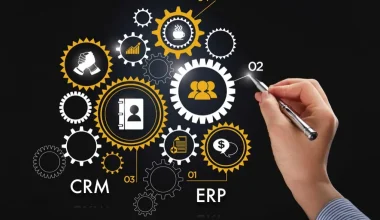Decentralizing the organization can be a smart step for your business or company, though it also requires the full support of all employees. A decentralized organizational structure has both advantages and disadvantages, so we’ll discuss the differences between the two with an example of each to help you decide whether this is the best structure for your business. We will also explain the differences between decentralized vs centralized organizational structure.
Decentralized Organizational Structure
In a corporation with a decentralized organizational structure, the lower-level employees make the majority of decisions rather than the senior management team. Occasionally, they include employees in the decision-making process.
The opposite of a decentralized organization is a centralized one, in which all significant decisions are made by the company’s highest-ranking officials within a tight decision-making structure. The majority of businesses are neither wholly decentralized nor centralized, but instead, have varying degrees of both.
Among the most prevalent instances where the decentralized organization is effective are the following:
- For the provision of multichannel customer service, a company must have multiple customer touchpoints and each will demand a highly personalized treatment.
- A decentralized structure is whenever a corporation has a significant number of separate shop locations and its senior management is unable to oversee all of them and make crucial decisions for them.
- Once the market for a particular product is dynamic and there is considerable competition, they must make all decisions swiftly.
- Where continual innovation alters the company model and makes centralized control ineffective.
Guidelines for Decentralized Organization Implementation
Let’s evaluate the guidelines for ensuring that a decentralized organization is efficient and effective.
- Discuss Pertinent Information With Local Managers. Ensure that all local managers who are also decision-makers have access to all of the necessary information to make properly informed judgments.
- Encourage Continuous Bottom-up Feedback. Requesting feedback from lower-level employees is a useful method for gathering information about the performance of each local manager. It can be public or anonymous, and in any case, it can be useful to uncover numerous managerial flaws.
- Place a Premium on Quality While Recruiting New Personnel. Possibly the most significant aspect of a successful decentralized organization is the talents and work ethic of the decision-making mid-level managers. In light of this, it is even more vital for this form of managerial structure to conduct quality recruitment.
- Develop and Manage a Comprehensive Strategy. Even though a decentralized organizational structure distributes decision-making obligations among multiple employees, a centralized strategy that ensures all employees are working toward the same overarching objectives can aid in the successful implementation of the organization’s long-term strategies.
- Evaluate Decision-Makers Based on their Performance. Rather than tracking each local manager’s decision, it is typically more accurate for the company’s senior management team to evaluate a manager’s performance based on the manager’s results. This provides local managers with the autonomy to make their own decisions and allows senior management to maintain only local decision-makers of the highest caliber.
There are two organizational systems available: decentralized and centralized. And we will be checking out the comparison between the two (centralized vs decentralized) in an organizational or business structure.
Centralized vs Decentralized Organizational Structure
In comparing the differences between centralized vs decentralized in an organizational structure, the basis and principles of a firm explain the management of business activities within an organizational framework. Small business owners are typically responsible for establishing the company’s organizational structure, which frequently reflects the owner’s personality, management style, and traits.
However, for business owners, each structure has advantages and disadvantages, which we will be looking into.
Centralized vs Decentralized Organizational Structure: Regulation of Centralization
The term “centralization” refers to a centralized location or group of administrative professionals responsible for planning, decision-making, and action-taking. This organization’s senior management holds all of its important rights and powers. In the past, it was normal practice to centralize all of an organization’s authority in a single location. Consequently, upper-level management had complete influence over medium and lower-level management. Aside from that, personal leadership and coordination are visible, as is the ease with which staff members may distribute their tasks.
Advantages of Centralized Administration
Among the benefits of effective centralization are the following:
#1. An Effective Communication Chain
A centralized organization benefits from a transparent communication chain since everyone knows who to report to. When junior employees have company-related issues, they know who to approach. On the other hand, senior executives have a well-defined structure for delegating responsibilities to personnel who excel at particular tasks. A clear chain of command is advantageous when a business wishes to make decisions quickly and consistently.
#2. Clear Sight
When a company has a centralized management structure, it can concentrate on attaining its vision with relative ease. There are open channels of communication, and the senior executive is able to communicate the organization’s goal to employees while simultaneously directing them to achieve it. The uncomplicated implementation of an organization’s vision and plans is made possible by its vision’s top-down direction. As a result, customers, suppliers, and communities receive a consistent message from the firm as a result.
#3. Economic
A centralized business adheres to standard operating procedures and systems, which reduces office and administrative costs.
There is no need to deploy more divisions or equipment to other locations because t the headquarters of the majority of the company’s decision-makers. In addition, since crucial decisions are made at the corporate level and subsequently distributed to the branches, the company does not need to spend extra money on hiring specialists. Lastly, the organization’s communication route prevents the duplication of positions, which would incur additional expenses.
#4. Decision-Making is Elementary
A small number of individuals in a centralized organization make choices and communicate them to lower-level administrators. The decision-making process is more effective when it involves only a few people. They communicate the decisions to the lowest levels of the organization for implementation.
#5. Increase in Efficiency
The established procedures and increased control of a centralized organization result in enhanced work quality. Each department has a supervisor responsible for ensuring output consistency and quality. Utilizing contemporary equipment reduces manual labor’s potential for waste and aids in assuring high-quality output. Work standardization also reduces task duplication, resulting in inflated labor costs.
Disadvantages of Centralized Administration
These are some of the disadvantages of centralization:
#1. Bureaucratic Command
Centralized management is akin to authoritarian leadership in that employees only produce results based on directives from the top executives. Employees are unable to contribute to the decision-making process of the business and are only responsible for implementing decisions made at a higher level. Since CEOs are only decision-makers and not decision-implementers, they will not comprehend when staff has trouble implementing certain decisions. As a result of these actions, employee performance declines since they lack the motivation to engage in decisions made solely by senior-level managers.
#2. Remote Control
The company’s management is under a great deal of pressure to make choices, but they have no influence over the implementation. The failure of CEOs to decentralize decision-making results in a substantial increase in their workload. Consequently, CEOs may make an excessive amount of decisions that are poorly implemented or ignored by workers.
#3. Occupational Delays
Work will slow down with the movement of records to and from the central office. There will be a loss of person-hours if there is a delay in transmitting information to the workforce. In addition, if staff wait for lengthy periods for instructions on their subsequent activities, they will be less productive.
#4. Employee Discontentment
When employees can take initiative in their work, they become more devoted to the firm. They are able to demonstrate their creativity and provide novel methods for accomplishing particular tasks. When work is centralized, however, there is minimal initiative because employees do duties that are conceptualized by senior executives. Due to the rigidity of the assignment, there is a bridge to the creativity and dedication of the company.
Centralized vs Decentralized Organizational Structure: Regulation of Decentralization
Decentralization is a business structure in which several organizational levels make decisions. Generally, the decentralized organizational structure is divided into smaller parts or groups for the purpose of facilitating the evaluation of the company’s success and the personnel within each subgroup. Many businesses operate in highly competitive industries and markets. To be successful, a company must work diligently to develop strategic competitive advantages that set it apart from its competitors. To do this, the company’s organizational structure must permit rapid adaptation and capitalization on opportunities. Consequently, in order to maintain a competitive advantage, numerous businesses employ a decentralized organizational structure.
Advantages of Decentralized Administration
Decentralized management has numerous advantages, including:
#1. Rapid Decision-Making and Reaction Times
It is important to implement the choices immediately. In order to remain competitive, businesses must also seize opportunities that correspond with their entire strategy.
#2. Greater Capacity to Extend the Business
It is crucial for businesses to constantly seek out novel methods to provide clients with goods and services.
#3. Demand-Based Training
Organizations must spend on developing highly trained individuals who can make well-informed decisions to help them reach their objectives.
#4. Appraisals
A wage boost typically includes promotional prospects. Moreover, in a decentralized organization, there is a link between a wage increase and additional responsibilities, such as acquiring new skills, having more decision-making authority, and overseeing other employees.
#5. A More Efficient Use of Management
To achieve success, a business must perform multiple duties. In decentralized businesses, lower and middle management usually carry out the majority of these responsibilities. Due to this, managers can gain expertise and proficiency in numerous areas.
Disadvantages of Decentralisation
While a decentralized organizational structure can be advantageous for many businesses, it also has disadvantages, including:
#1. Difficulty Coordinating
Coordination issues are crucial for an organization to operate toward a common goal. Because there is a delegation of decision-making to a decentralized organization, it can be challenging to confirm that all company sectors are collaborating to achieve the organization’s strategic objectives.
#2. Increased Expenses
Because all sections of an organization must make the same decisions and engage in the same activities, decentralized organizations are prone to duplicate efforts, resulting in inefficiency and increased costs.
#3. Discordance in Operations
When there is a diffusion of authority throughout the organization, as it is in decentralized organizations, division managers may drive the optimization efficiency and serve the organization’s best interests through the customization of divisional operations. In this system, it is essential that the shortcuts of one division do not interfere with or interrupt the activities of another division.
#4. Self-Centeredness
Typically, separate divisions within an organization are evaluated based on division success as opposed to overall company performance. In a decentralized organization, division managers may place divisional objectives ahead of organizational objectives. Leaders of decentralized companies must guarantee that all divisions prioritize and achieve the organization’s objectives.
Because decentralized organizations have a great deal of autonomy, divisions may become operationally detached from other divisions and concentrate primarily on their own interests. In addition, if divisional or departmental managers lack diverse experience or skills due to a lack of access to other specialists, the division may be at a disadvantage.
Centralization vs Decentralization
Here are a few factors to consider while comparing or choosing between the two options( centralized vs decentralized) in an organizational structure.
- The process of comparing between centralized vs decentralized organizational structure, centralization is the concentration of power and authority in the hands of top management. Decentralization, on the other hand, refers to the delegation of power and responsibility from the top to functional-level management.
- Centralization is the systematic and continual consolidation of power at central points. In contrast, decentralization is the methodical devolution of authority within an institution. Centralization is appropriate for a small organization, whereas decentralization is appropriate for a large business.
- A centralized organization is capable of formal communication. In contrast, decentralization disperses communication.
- Due to the reliance of all authorities on the judgments of a single institution, the decision-making process is now under centralization. Decentralization, on the other hand, is more successful in decision-making because they make decisions closer to the action.
- The leadership and coordination provided by centralization are exhaustive. Decentralization distributes the burden of executive management.
- In centralized vs. decentralized organizational structures, centralization applies when an organization’s administration is not under sufficient control. In contrast, decentralization applies when the management of an organization is completely under control.
To advance our knowledge of what a decentralized organizational structure is, here is an example to enhance our understanding of it.
Decentralized Organizational Structure Example
A decentralized organizational structure has so many attributes to it, however below is the easiest understanding example of it.
- If you own a distant business, for instance, you may gain more from a decentralized structure. Unless you own a tech company, a centralized organization may be more advantageous.
- Open Source Software is one of the two examples where decentralization works in the field of computer organization.
- The Internet is a prime example of a decentralized organizational structure in our time. The purpose of its creation was intended to circumvent the limitations of centralized military leadership and the possibility of missile assault. This decentralized structure is based on the humble hyperlink, which connects all of the individual pages, websites, and networks.
- Terrorist cells are the best example of a decentralized organizational structure in the military. This explains the difficulty the West has had in accepting Al Qaeda, locating Osama bin Laden, and fighting in Afghanistan.
- Alcoholics Anonymous is not structured in the conventional sense. The local members who are responsible for establishing it governs the chapters. Hence, a strong philosophy supports this decentralized organization’s work, which is its greatest asset.
- In peer-to-peer software, the sharing of information is among a large number of users. Bit Torrent, for instance, downloads a portion of a file from several computers located across the world.
- If the internet is the classic example of a decentralized organizational structure in our time, then our brain is the physical equivalent. While our brains control our bodies centrally, the structure of our brains is quite distinct. It is a neuronal network. While the loss of certain brain regions will result in a loss of function, it is possible that the brain can rewire itself as it acquires new information.
Decentralized Organizational Structure Advantages and Disadvantages
As we have all learned, the term “decentralization” refers to a specific type of organizational structure in which the higher leadership delegates decision-making responsibilities and everyday operations to lower-level subordinates. Decentralization can be a necessity for some businesses in order to keep their operations running smoothly. However, here are the advantages and disadvantages of a decentralized organizational structure.
The Advantages of Decentralization
The following are the benefits of decentralization in an organizational structure:
#1. Subordinates’ Sources of Inspiration
It has been shown that decentralization boosts both job satisfaction and morale, especially among middle and lower-level managers.
The goal is to meet the many needs of participation, independence, and status for all those who participate. Decentralization also fosters a sense of belonging and camaraderie among members of a team. Invention and Expansion
In a decentralized environment, each product division is given the freedom to express its individuality. Top-level management can foster healthy rivalry throughout the various divisions by doing so in this way.
When weighing the advantages and disadvantages of a decentralized organizational structure, keep in mind that it empowers subordinates to make their own decisions. To secure the long-term viability of a business, they also build management skills and help with succession planning.
#2. Making Quick and Informed Decisions
One of the most essential aspects of the decentralized advantages and disadvantages of an organizational structure is that decisions are made and implemented by authorized employees. As a result of this, better decisions may be made more quickly and accurately.
#3. Effectiveness in Conversation
Decentralization reduces the number of hierarchical levels because of the greater scope of management. As the level of trust between managers and their employees grows, so does the effectiveness of the communication system.
#4. Affordability for Growth
A growing company’s expansion can be slowed down or halted altogether if decentralization is implemented. As a result, new business units may be established in different parts of the world.
Decentralization allows the organization to operate at its best potential while also responding more quickly to localized needs.
#5. Improvements in Supervisory and Controlling
Lower-level supervisors have the authority to make changes to production schedules and work assignments. It is possible for them to advocate for the promotion of their coworkers and even take disciplinary measures against them.
As a result of the advantages and disadvantages of a decentralized organizational structure, supervisory efficiency will still improve. And control can be effectively exercised by evaluating the performance of each dispersed unit.
#6. Fulfillment of Basic Human Requirements
One of the most essential ways to satisfy our basic demand for autonomy is through decentralization. As they take ownership of the company’s future, a group of contented managers grows throughout the organization.
#7. Executives are Relieved.
If employees at all levels assume responsibility for their own work, upper management can devote more time to higher-level tasks like strategic planning and decision-making. This reduces their workload, which in the long run benefits the organization as a whole.
The Disadvantages of Decentralization
The following are the drawbacks of decentralization in an organizational structure:
#1. Tough To Organize
When discussing the advantages and disadvantages of a decentralized organizational structure, it is important to keep in mind that each division has a great deal of autonomy. This, in turn, complicates the overall coordination of the project.
#2. Influences from the Outside
Decentralization may be thwarted by the labor movement, market uncertainty, and government action.
#3. Products with a Limited Number of Options
When looking into the advantages and disadvantages of a decentralized organizational structure, there must be a wide range of decentralized product lines so that autonomous units can thrive. Small businesses with limited product offerings may find this to be of limited utility. The challenge is exacerbated further because of the lack of capable leaders at the organization’s lower levels.
#4. It is Costly.
Employees in decentralized organizations assume responsibility for the success of the organization, and they work harder to accomplish all of its goals. In response, the corporation has to pay them extra, which can end up costing them a lot of money.
#5. It Can Lead to Regionalized Perspectives.
When local managers are given the authority to make their own judgments, there is a high likelihood that the decisions they make are not legitimate for the organization as a whole, as they are tailored to the needs of that branch. This might lead to situations where unprofitable branches are kept operational for longer than necessary. However, this risk can be minimized by providing regional managers with specialized training and by identifying strategies to hold them accountable for their own judgments.
#6. It Can Preserve Valuable Data at the Local Level.
Local branches that are efficiently managed may not share their procedures and decision-making processes with the rest of the corporation. This can be prevented if higher management makes a concerted effort to identify and promote effective local practices within the firm.
#7. Branches May Employ Vastly Distinct Processes
Given that each local manager has the authority to make their own judgments regarding their branch, there is a substantial possibility that, over time, each branch will operate differently than the others. This can make it difficult for the organization as a whole to regulate variables such as quality standards. Typically, this can be avoided by fostering frequent contact between local offices and higher management.
Conclusion
Consider your overall business objectives, available resources, and the type of organization you’re operating when deciding which framework is appropriate for your company.
Some other examples like the starfish which is the best example of decentralized organizational structure in the animal kingdom. Also, the Apache Indians are a typical example of a decentralized organizational structure in our community. This made it incredibly tough for the Spanish Conquistadors to subdue them, as they were unable to locate the tribe’s primary authority.
If you are a global brand, you may discover that having a centralized headquarters and decentralized franchisees is the optimal business model for you. As long as you focus on the most effective leadership model for your business and team, you will be able to strike a balance that benefits the entire organization.
What Are the Example of Decentralized Organization?
If you own a distant business, for instance, you may gain more from a decentralized structure. Unless you own a tech company, a centralized organization may be more advantageous.
What Is Centralized and Decentralized Organizational Structure?
The process of centralization is the concentration of power and authority in the hands of top management. Decentralization, on the other hand, refers to the delegation of power and responsibility from the top to functional-level management.
What Is Decentralization?
In a corporation with a decentralized organizational structure, the majority of decisions are made by lower-level employees rather than the senior management team. Occasionally, employees are even included in the decision-making process.
What Is Decentralisation in Business?
To do this, the company’s organizational structure must permit rapid adaptation and capitalization on opportunities. Consequently, in order to maintain a competitive advantage, numerous businesses employ a decentralized management structure.
What Are the 3 Forms of Decentralization?
This bibliography outlines four primary types of decentralization based on UNDP and World Bank article categories. There are four types of decentralization: political, administrative, fiscal, and market. Political decentralization is the delegation of power to subnational bodies.
What Are Limitations of Decentralization?
There is a lack of consistency in the implemented policies. There will be a coordination issue. It will necessitate the appointment of qualified and trained employees.
Does Decentralization Achieve More Positive or Negative Effects?
Indirectly, it may also contribute to the power of the state, as its success will likely increase its legitimacy and authority. Public response to basic necessities is one of the most commonly mentioned and persuasive arguments in favor of decentralization.
Related Articles
- What is a Cryptocurrency? How it Works, Risks & Tips
- Crypto Exchange: How to Pick the Best & Safest Options
- Mining Bitcoin and Expanding Your Wallet
- What is Bitcoin? History, How it Works & All You Need
- Blockchain Technology Simplified!!! (+ All you Need)
- CHAIN OF COMMAND: Definition, Meaning & Examples
- QUALITY ASSURANCE VS QUALITY CONTROL: Differences And Examples






